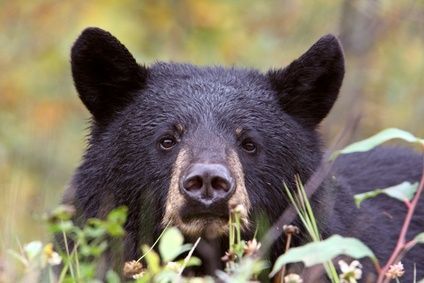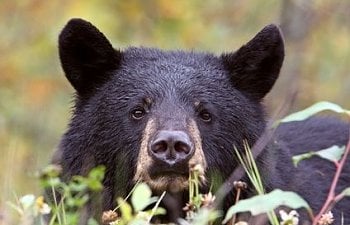Bear
General Information and description
Bears are omnivores in the Ursidae family. They are found mostly in North America, Europe and northern and central Asia. The most common are the American Black Bears, which roam in North America and enjoy a widespread population. Bears generally have large shaggy bodies with short stubby tails. They walk and run on all fours, but can stand on two stocky legs when reaching for food or attacking to frighten their enemies. They are also observed to sit like humans. Bears have a large head with a long snout. They have plantigrade paws with five non-retractable claws. Despite their heavy build and gait, they are known to run as fast as 30 mph as well as being excellent climbers and swimmers.
Range
Bears roam forests and are the most social of all mammals. They enjoy living in solitude. These creatures are highly adaptive and will change their behaviors to fit in with environmental changes. They thrive near human settlements, where they scavenge garbage cans at night. They get easily attracted by the smell of processed or cooked meats, stored honey or livestock feed. In the wild, they live in caves or burrows, and are known to go into extended sleep or hibernation during the winter months.
Method of kill
Bears are generally omnivorous. Their greatest predatory edge is their heightened sense of smell, which guides them to their prey. These powerful olfactory senses are believed to be more powerful than those of dogs or any other mammal. Unlike most predators (like raccoons, crows, rats, foxes, opossums, and cats) who will lie in wait until no one is around to strike, bears attack and break through your defenses — especially when faced with food he enjoys. These animals can easily destroy picket fences and small wood sheds just to get to your chicken feeds. Along the way, they will eat as many panicking chickens as they can as they tear through the coop using their sharp claws.
Prevention & Treatment
Visiting bears can cause a lot of problems and damage to your poultry farm. The best bear protection for your poultry farm is prevention. Do not to give bears any reason to visit your area. There are a number of preventative measures you can take to protect your flock. Bears find the aroma of chicken feeds irresistible and the smell of chicken feed is enough of an invitation. To remedy the situation, make sure that you use secure feed storage bins to store your poultry feeds. Cover your garbage cans and never leave cooked meats and fish in your pet food bowls. As an added insurance, build a secure, predator proof chicken coop and run. A very effective barrier for curious bears is an electric fence.
While dogs have been known to attack chickens and devour their young, they can be trained as puppies to leave the chickens alone and become livestock guardian dogs that will protect your flock and deter predators instead. Have at least two or three of them around your backyard. While there is no guarantee that bears will not intrude, guard dogs can be an effective deterrent.
For more discussions on bears and how to protect your flock against them, visit the Predators and Pests section of the forum.
General Information and description
Bears are omnivores in the Ursidae family. They are found mostly in North America, Europe and northern and central Asia. The most common are the American Black Bears, which roam in North America and enjoy a widespread population. Bears generally have large shaggy bodies with short stubby tails. They walk and run on all fours, but can stand on two stocky legs when reaching for food or attacking to frighten their enemies. They are also observed to sit like humans. Bears have a large head with a long snout. They have plantigrade paws with five non-retractable claws. Despite their heavy build and gait, they are known to run as fast as 30 mph as well as being excellent climbers and swimmers.
Range
Bears roam forests and are the most social of all mammals. They enjoy living in solitude. These creatures are highly adaptive and will change their behaviors to fit in with environmental changes. They thrive near human settlements, where they scavenge garbage cans at night. They get easily attracted by the smell of processed or cooked meats, stored honey or livestock feed. In the wild, they live in caves or burrows, and are known to go into extended sleep or hibernation during the winter months.
Method of kill
Bears are generally omnivorous. Their greatest predatory edge is their heightened sense of smell, which guides them to their prey. These powerful olfactory senses are believed to be more powerful than those of dogs or any other mammal. Unlike most predators (like raccoons, crows, rats, foxes, opossums, and cats) who will lie in wait until no one is around to strike, bears attack and break through your defenses — especially when faced with food he enjoys. These animals can easily destroy picket fences and small wood sheds just to get to your chicken feeds. Along the way, they will eat as many panicking chickens as they can as they tear through the coop using their sharp claws.
Prevention & Treatment
Visiting bears can cause a lot of problems and damage to your poultry farm. The best bear protection for your poultry farm is prevention. Do not to give bears any reason to visit your area. There are a number of preventative measures you can take to protect your flock. Bears find the aroma of chicken feeds irresistible and the smell of chicken feed is enough of an invitation. To remedy the situation, make sure that you use secure feed storage bins to store your poultry feeds. Cover your garbage cans and never leave cooked meats and fish in your pet food bowls. As an added insurance, build a secure, predator proof chicken coop and run. A very effective barrier for curious bears is an electric fence.
While dogs have been known to attack chickens and devour their young, they can be trained as puppies to leave the chickens alone and become livestock guardian dogs that will protect your flock and deter predators instead. Have at least two or three of them around your backyard. While there is no guarantee that bears will not intrude, guard dogs can be an effective deterrent.
For more discussions on bears and how to protect your flock against them, visit the Predators and Pests section of the forum.


